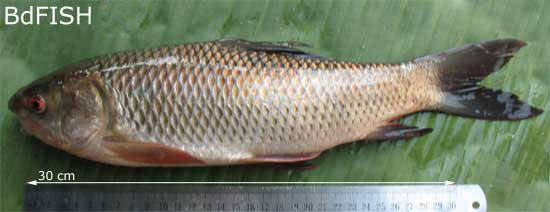
Synonyms:
Cyprinus rohita; Hamilton, 1822
Labeo rohita; Day, 1878
Labeo rohita; Shaw and Shebbeare, 1937
Labeo rohita; Bhuiyan, 1964
Common name: Rohu
Local name: Rui, Rohit, Rou
Taxonomy position:
Phylum- Chordata
Class-Oesteichthyes
Order- Cypriniformes
Family- Cyprinidae
Genus- Labeo
Fin formula:
D. 15-16 (3/12-13); P1. 16-17; P2. 9; A. 7(2/5). (Rahman, 2005)
Description of the species:
According to Talwar and Jhingran (1991), body moderately elongate, its dorsal profile more arched than the ventral profile, snout fairly depressed, nostrils two pairs and at anterior superior angle of orbits, gill-openings wide. Gills rakers feeble and arranged at short intervals, lateral line complete, scales moderate. According to Rahman, (1889) it attains over 90 cm in total length.
Habit and Habitat:
Its food comprises crustaceans and insect larvae in early stages (Mookerjee et. al., 1946). The percentage composition of food of L. rohita may be algae 35%, higher plants 20%, protozoa 23%, crustaceans 15%, mud and sand 7%. L. rohita takes small percentages of mud which contains organic matter and various salts. This species is available throughout Bangladesh. Ponds, rivers, rivulets are its main habitats (Bhuiyan, 1964). The fecundity of this species varies form 2,26,000 to 2,79,4000 depending upon the length and weight (Talwar and Jhingran,1991)
Economic importance:
Rohu is regarded an excellent game fish and seems to put up a better fight in a river than in a tank. A number of interspecific and intergeneric hybrids have been produced. The most promising intergeneric hybrid, male Catla ´ female Rohu combines the quick growth of Catla and small head of Rohu (Talwar and Jhingran, 1991).
Ecological role:
Rohu is bottom feeder and prefers to feed on plant matter including decaying vegetation.
Status and conservation
This fish is available in the study area. Not listed in IUCN Red list (IUCN, 2000).
References:
Bhuiyan, A. L. 1964. Fishes of Dacca. Asiatic Society of Pakistan, Dacca. p 21.
Day, F. 1878. Fishes of India, being a natural history of fishes known to inhabit the seas and freshwaters of India, Burma and Ceylon. William Dawson & Sons Ltd., London, Vol. I: p 538.
Hamilton, F., 1822. An account of the fishes found in the river Ganges and its branches, Edinburgh & London, Fishes Ganges, p 301.
IUCN Bangladesh. 2000. Red Book of Threatened Fishes of Bangladesh. IUCN- The World Conservation Union. xii+116 pp.
Mookerjee, H. K., Sen Gupta, S. N. and Roy Choudhury, D. N. 1946. Food and its percentage composition of the common adult food fishes of Bengal. Sci. & Cult. Calcutta. 12 (7): 247.
Rahman, A.K.A. 1989. Freshwater Fishes of Bangladesh. The Zoological Society of Bangladesh, Department of Zoology, University of Dhaka, Dhaka-1000. p 116.
Rahman, A.K.A. 2005. Freshwater Fishes of Bangladesh (Second edition). The Zoological Society of Bangladesh, Department of Zoology, University of Dhaka, Dhaka-1000. 394 pp.
Shaw and Shebbeare, 1937, The Fishes of Northern Bangal. Journal of Royal Asiatic Society of Bengal Science. p 57.
Talwar, P. K. and Jhingran, A. G., 1991. Inland Fishes of India and Adjacent Countries. Volume 1. Oxford & IBH Publishing Co. Pvt. Ltd. New Delhi, Calcutta. p 219.
Visited 11,141 times, 1 visits today | Have any fisheries relevant question?
